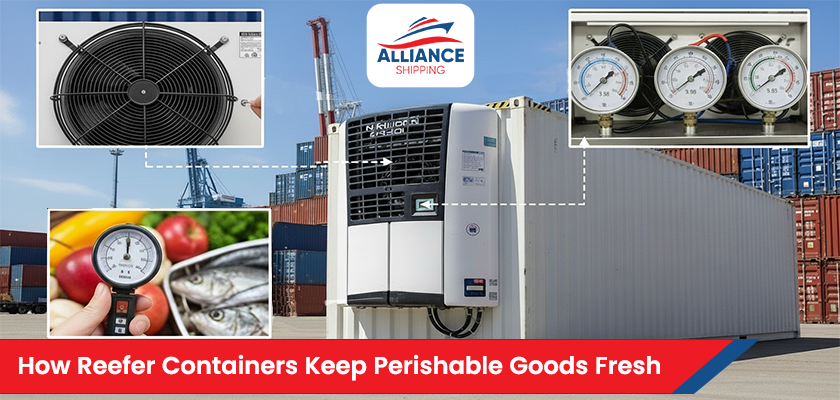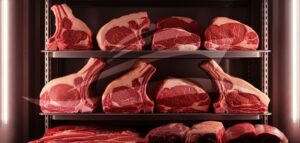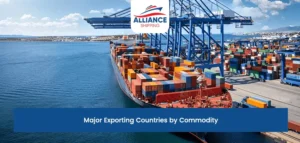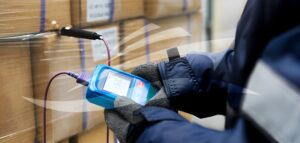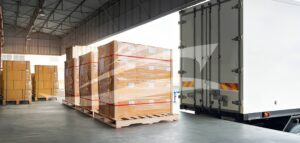In the shipping industry, a wide variety of commodities is transported worldwide. Electronics, clothing, machinery, and many other goods each require specific handling. However, perishable commodities such as fresh fruits, vegetables, seafood, and medicines demand special care. These items can spoil or decay within a short time.
Regular shipping containers are designed only to keep goods dry and protected from outside weather. And can not handle the import and export of perishable items. This is where “reefer containers” are used. They are specially designed to create a controlled environment for any goods that need it.

What are Reefer Containers?
Reefer containers, also known as refrigerated containers, are specialized shipping units designed for goods that require temperature control. They are widely used for transporting fresh produce, frozen foods, pharmaceuticals, and other temperature-sensitive cargo.
Each reefer container is fitted with advanced refrigeration systems, insulation, and ventilation to maintain a consistent temperature throughout the journey. This ensures the cargo remains fresh, safe, and in good condition upon arrival.
Reefer containers typically come in two main sizes: 20ft and 40ft high cube.
The 20ft option is smaller, suitable for limited shipments, local deliveries, or when vessel space is restricted. The 40ft high cube container is larger and commonly used for bulk shipments of fruits, vegetables, meat, and seafood.
History of Reefer Containers
In the 19th century, when international shipping started to grow, products like seafood, meat, and fruits were also being sent across seas. However, long voyages often caused these perishable goods to spoil before reaching their destinations, reducing their value.
To slow down spoilage, shipping companies initially used ice and salt to keep cargo at lower temperatures during transit. While this method helped for a time, it was not consistently reliable. Then, in the 1960s, a US company called Matson Navigation introduced the first reefer container with its own built-in refrigeration unit.
The innovation by Matson Navigation made it possible to keep cargo at the right temperature for the entire trip. By the 1970s, refrigerated containers were built specifically for container ships, which made shipping perishable goods by sea much easier and more reliable.
How Reefer Containers Keep Perishable Goods Fresh
Reefer containers are highly engineered units. They are not just simple refrigeration boxes. These containers combine cooling technology, controlled airflow, and advanced monitoring systems to keep perishable cargo safe and in good condition during transit.
Each feature has a critical role in maintaining freshness and reducing the risk of spoilage.
Cooling System
A reefer container comes with its own built-in refrigeration unit, usually fixed at one end of the container. It is not like the refrigerator you have at home. Instead, it is a heavy-duty industrial cooling system made specifically for transporting cargo.
It is engineered to run continuously, whether the container is onboard a vessel, mounted on a truck, or placed in a storage yard. The unit uses refrigerant gases (like R134a or R404A) and delivers several kilowatts of cooling power, which is strong enough to hold precise temperature set points anywhere between -30°C and +30°C.
To make sure the cold reaches every corner, the container floor is built with a “T-floor” design that pushes chilled air evenly across all the cargo. On top of that, the walls, floor, and ceiling are fully insulated to trap the cold inside and block outside heat.
Let’s look at the main types of reefer containers and the temperature ranges they can maintain.
| Type of Reefer Container | Temperature Ranges |
| 20ft standard reefer | -30°C to +30°C |
| 40ft high cube standard reefer | -35°C to +30°C |
| 40ft high cube controlled atmosphere reefer | -30°C to +30°C (O₂: 2–21%, CO₂: 2–20%) |
| 40ft high cube super freezer | -60°C to -20°C |
Airflow and Temperature Distribution
Once the cooling systems are installed, the next element is the even airflow in the entire container. That’s why reefer containers use a special T-floor, also called a channeled flooring system, that pushes chilled air from the bottom and spreads it throughout the container.
This way cold air reaches every pallet and box, not only the goods placed near the cooling unit. The steady circulation prevents uneven temperatures, so there are no hot or overly cold spots inside. Good airflow also controls humidity and reduces condensation, which keeps the packaging safe and the products fresh during long journeys.

Advanced Monitoring Systems
Modern reefer containers come with digital monitoring and control systems. Sensors track various factors such as temperature, humidity, and airflow in real time. If there is any change, it is detected immediately, and corrective action can be taken before the cargo is affected.
Many containers have controlled atmosphere (CA) systems that adjust oxygen and carbon dioxide levels to slow the natural ripening of fruits and vegetables. They also regulate humidity, which prevents products from drying out or taking in excess moisture.
Temperature settings are carefully matched to each type of cargo. For example, bananas are shipped at about 13°C, dairy products between 2°C and 4°C, and frozen seafood at temperatures as low as -25°C.
How Reefer Containers Get Power?
Now that you know about reefer containers, you might wonder how they use electricity. There are several ways this is done, such as:
- On ships: Plugged into the vessel’s electrical system through reefer sockets.
- At ports or storage yards: Connected to fixed power outlets until loading or pickup.
- On trucks or trains: Powered by a diesel generator set (genset) attached to the container.
The Future of Reefer Containers
The role of reefer containers in trade today is huge, and it is expected to grow even more in the coming years. That is why container manufacturers keep designing new models to make improvements in reefer containers. These companies are also focusing on reducing waste and protecting the environment.
In addition, smarter tracking tools are giving shippers and customers better visibility and control over their cargo throughout the journey. With these advancements, reefer containers are moving toward a future where transporting perishable goods is more reliable, sustainable, and efficient.
In the end, reefer containers are now very important for global trade, especially for perishable goods. They keep food, medicine, and other sensitive cargo fresh, safe, and well-protected during transport. As technology improves, these containers will become even more important in making supply chains reliable and environmentally friendly.


